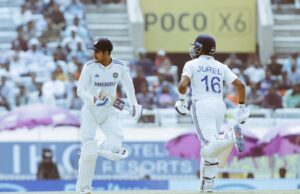
As Dhruv Jurel ran a couple to take India over the line in the fourth Test against England in Ranchi, Sunil Gavaskar chose to look beyond the winning moment and peeked into the future.
“Lovely to see these youngsters celebrate, taking India home. This will be something that they will remember all their lives. When you play a hand in taking your country to a win, it is an extraordinary feeling. In the hands of these two youngsters (Jurel and Shubman Gill) Indian cricket will rely on more such victories over the next decade-and-a-half. Both in their early twenties, so they will be playing 15, if not more years,” the legendary opener and former India captain said on air.
Mind raced back to a BCCI email that landed in the inbox a little over a month ago. The five-Test series was about to begin, when the board informed of Virat Kohli’s withdrawal from the first two games due to personal reasons. Kohli would eventually pull out of the series, but initially the decision came as a shock. It also created a massive void in the middle-order.
The Ajit Agarkar-led selection committee had an option to revisit the past and bring back Cheteshwar Pujara. With his truck-load of experience and proven quality, Pujara could have been a readymade solution. He had been scoring heavily in Ranji Trophy. Ajinkya Rahane was there as well, leading Mumbai in the country’s premier red-ball domestic tournament. But with eyes fixed on transition, the selectors and the team management refused to look back.
Rajat Patidar was added to the squad instead, on the back of his fine performance for India A. It’s a different matter that Patidar was a disappointment at the Test level, but the message from the Indian cricket system was loud and clear — going ahead, youth will be preferred.
India lost the first Test in Hyderabad and the news came on its heels that KL Rahul and Ravindra Jadeja would miss the second in Visakhapatnam. Suddenly, India’s batting became very thin on quality and experience. The selectors’ response was to bring on Sarfaraz Khan, Washington Sundar and Sourabh Kumar, shunning popular choices.
Jurel was part of the original squad despite playing just 15 first-class matches before this Test series. When KS Bharat’s batting became a matter of concern, the team management decided to throw the 23-year-old in at the deep end. The bold calls have paid off spectacularly. The irreverence of youth has helped India secure a memorable series win against an England side that revelled in its Bazball-fuelled intensity.
Yashasvi Jaiswal, 22, has scored 655 runs in four Tests, including two double hundreds. Jurel, 23, has played two match-winning knocks only in his second Test. Sarfaraz, 26, had an excellent debut in Rajkot. Gill, 24, was teetering on the edge, taking time to settle in the No. 3 position. How well has he bounced back! Akash Deep, 27, had the impossible task of replacing Jasprit Bumrah. He made a mark with three wickets in the opening session of the fourth Test.
Tune into our morning show:
Tea-ing Off with RevSportz || LIVE https://t.co/PZjIozXHUB
— Boria Majumdar (@BoriaMajumdar) February 27, 2024
Little wonder then, that Rohit Sharma waxed lyrical about the young players after winning the series in Ranchi. “These guys who have come in have done the job perfectly. They have taken the responsibility perfectly and you can take a lot of pride from performances like this with inexperienced players,” the India captain said at the post-match press conference.
There’s a mid-90s feel in this transition, 1996 to be precise, when Indian cricket had gone through a mini upheaval. Navjot Sidhu fell out with captain Mohammad Azharuddin in the middle of a Test series in England and returned home. Sanjay Manjrekar picked up an injury ahead of a Test and the team had to turn to two youngsters, Sourav Ganguly and Rahul Dravid. India got two players for the long haul, who would eventually combine as captain and vice-captain to change the face of Indian cricket. VVS Laxman and then, Virender Sehwag, Yuvraj Singh, Zaheer Khan, Ashish Nehra and Harbhajan Singh would come in their wake.
The current crop of youngsters, the Jaiswals, the Gills and the Jurels, too, are giving the feel that they are here to stay. All of them are a work in progress and in the end, they will be judged by their overseas exploits, in the SENA (South Africa, England, New Zealand and Australia) countries. But there’s serious promise on offer, a group of young Turks with the hunger to excel in Test cricket.
“Moving forward, it’s a big plus for us with a lot of these guys coming and showing that they belong here. I know it’s still early days, but they have shown that they have all the ability, and all the skills to excel in this format,” Rohit said.
As India chased a tricky target on the fourth day of the Ranchi Test, head coach Dravid had a motivational two-liner for his boys: “If not you, then who? If not now, then when?” After the victory, Gill shared it via an Instagram post. The young guns stood up to repay their coach’s faith. Transition in Indian cricket has begun in earnest.
For more sports information: https://revsportz.in/